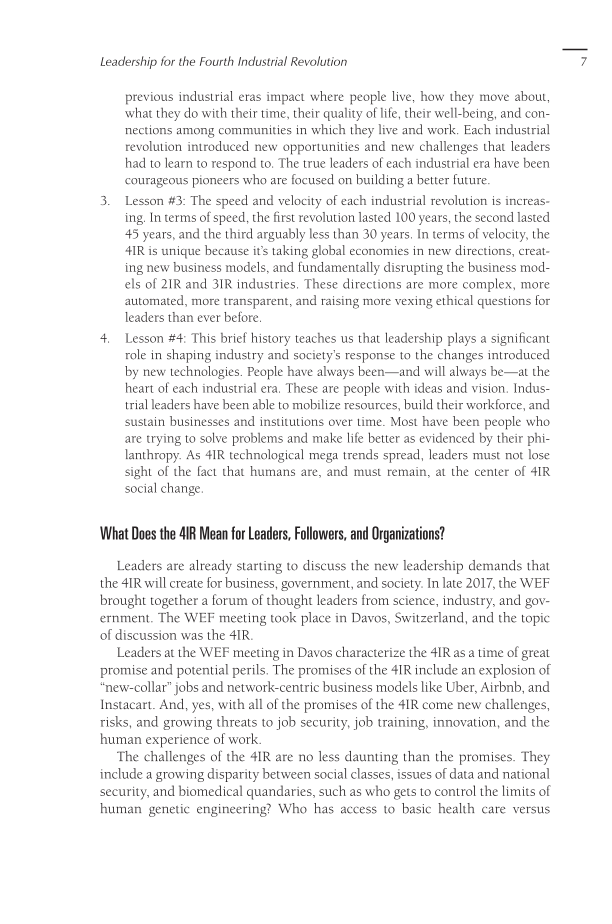Leadership for the Fourth Industrial Revolution 7 previous industrial eras impact where people live, how they move about, what they do with their time, their quality of life, their well-being, and con- nections among communities in which they live and work. Each industrial revolution introduced new opportunities and new challenges that leaders had to learn to respond to. The true leaders of each industrial era have been courageous pioneers who are focused on building a better future. 3. Lesson #3: The speed and velocity of each industrial revolution is increas- ing. In terms of speed, the first revolution lasted 100 years, the second lasted 45 years, and the third arguably less than 30 years. In terms of velocity, the 4IR is unique because it’s taking global economies in new directions, creat- ing new business models, and fundamentally disrupting the business mod- els of 2IR and 3IR industries. These directions are more complex, more automated, more transparent, and raising more vexing ethical questions for leaders than ever before. 4. Lesson #4: This brief history teaches us that leadership plays a significant role in shaping industry and society’s response to the changes introduced by new technologies. People have always been—and will always be—at the heart of each industrial era. These are people with ideas and vision. Indus- trial leaders have been able to mobilize resources, build their workforce, and sustain businesses and institutions over time. Most have been people who are trying to solve problems and make life better as evidenced by their phi- lanthropy. As 4IR technological mega trends spread, leaders must not lose sight of the fact that humans are, and must remain, at the center of 4IR social change. What Does the 4IR Mean for Leaders, Followers, and Organizations? Leaders are already starting to discuss the new leadership demands that the 4IR will create for business, government, and society. In late 2017, the WEF brought together a forum of thought leaders from science, industry, and gov- ernment. The WEF meeting took place in Davos, Switzerland, and the topic of discussion was the 4IR. Leaders at the WEF meeting in Davos characterize the 4IR as a time of great promise and potential perils. The promises of the 4IR include an explosion of “new-collar” jobs and network-centric business models like Uber, Airbnb, and Instacart. And, yes, with all of the promises of the 4IR come new challenges, risks, and growing threats to job security, job training, innovation, and the human experience of work. The challenges of the 4IR are no less daunting than the promises. They include a growing disparity between social classes, issues of data and national security, and biomedical quandaries, such as who gets to control the limits of human genetic engineering? Who has access to basic health care versus
Document Details My Account Print multiple pages
Print
You have printed 0 times in the last 24 hours.
Your print count will reset on at .
You may print 0 more time(s) before then.
You may print a maximum of 0 pages at a time.

































































































































































































